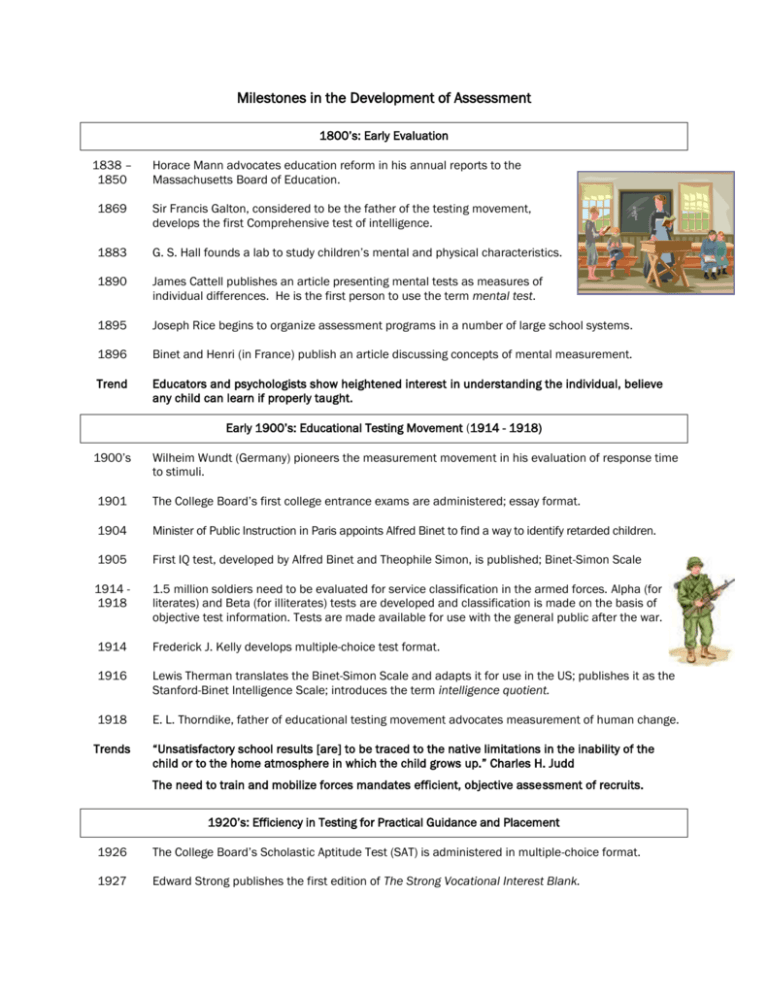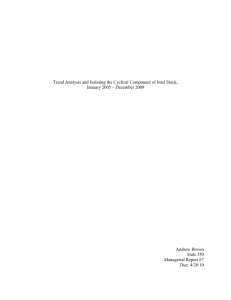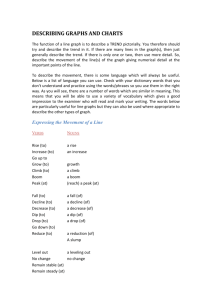Milestones in Development
advertisement

Milestones in the Development of Assessment 1800’s: Early Evaluation 1838 – 1850 Horace Mann advocates education reform in his annual reports to the Massachusetts Board of Education. 1869 Sir Francis Galton, considered to be the father of the testing movement, develops the first Comprehensive test of intelligence. 1883 G. S. Hall founds a lab to study children’s mental and physical characteristics. 1890 James Cattell publishes an article presenting mental tests as measures of individual differences. He is the first person to use the term mental test. 1895 Joseph Rice begins to organize assessment programs in a number of large school systems. 1896 Binet and Henri (in France) publish an article discussing concepts of mental measurement. Trend Educators and psychologists show heightened interest in understanding the individual, believe any child can learn if properly taught. Early 1900’s: Educational Testing Movement (1914 - 1918) 1900’s Wilheim Wundt (Germany) pioneers the measurement movement in his evaluation of response time to stimuli. 1901 The College Board’s first college entrance exams are administered; essay format. 1904 Minister of Public Instruction in Paris appoints Alfred Binet to find a way to identify retarded children. 1905 First IQ test, developed by Alfred Binet and Theophile Simon, is published; Binet-Simon Scale 1914 1918 1.5 million soldiers need to be evaluated for service classification in the armed forces. Alpha (for literates) and Beta (for illiterates) tests are developed and classification is made on the basis of objective test information. Tests are made available for use with the general public after the war. 1914 Frederick J. Kelly develops multiple-choice test format. 1916 Lewis Therman translates the Binet-Simon Scale and adapts it for use in the US; publishes it as the Stanford-Binet Intelligence Scale; introduces the term intelligence quotient. 1918 E. L. Thorndike, father of educational testing movement advocates measurement of human change. Trends “Unsatisfactory school results [are] to be traced to the native limitations in the inability of the child or to the home atmosphere in which the child grows up.” Charles H. Judd The need to train and mobilize forces mandates efficient, objective assessment of recruits. 1920’s: Efficiency in Testing for Practical Guidance and Placement 1926 The College Board’s Scholastic Aptitude Test (SAT) is administered in multiple-choice format. 1927 Edward Strong publishes the first edition of The Strong Vocational Interest Blank. 1928 Clark Hull’s Aptitude Testing suggests using standardized measures of aptitude to predict job satisfaction. Trend Return of soldiers to civilian work force necessitates development of career counseling and skill/interest assessment. 1930s: Connection Between Outcomes and Instruction/Accreditation Movement (Norm-referenced tests developed for use in measuring individual performance levels) 1932 Many large school systems in the US use group IQ test results to assign students to ability tracks. Colleges begin to base admissions decisions on applicants’ test scores. 1934 Ralph Tyler promotes inclusion of behavioral and content components in educational objectives. 1938 First Mental Measurement Yearbook is published. Trend Use of assessment is widespread among school systems. 1940s: The Need for Career Assessment and Counseling (1939 – 1945) 1939 The US Army establishes personnel and testing divisions to help soldiers adjust to civilian life. David Wechsler develops the Wechsler-Bellevue IQ test; is first to see the IQ test’s capability to provide insight into personality; understands importance of having a well-stratified sample. 1940 Army General Classification Test is published. 1948 Educational Testing Service (ETS) is formed. Trend Emphasis on applied use of test results calls for instruments to be aligned with standards. 1950s: Dissatisfaction with Public Education Parallels Technological Advancement (Soviet Union’s launch of Sputnik I in 1957) 1955 The high-speed scanner is invented; assessment becomes more efficient and less costly. 1958 National Defense Education Act endorses relationship between testing and career guidance and funds identification of outstanding students. Trend Provide counseling for secondary students with outstanding aptitude. 1960s: Expansion of State-Mandated Minimum Competency Testing 1964 The National Assessment of Educational Progress (objectives-based evaluation) begins under the direction of Ralph Tyler. 1960s Robert Glaser is first to use the term criterion-referenced measures to refer to tests that assess achievement of pre-specified objectives. Trend For a stimulus or concept to have meaning, there must be something in the learner’s cognitive structure to which it can be related. 2 1970s: Basic Skills Movement Parallels Use of Tests for Impersonal Categorization and Generalization (Proliferation of Associations and Journals) 1972 The government creates the National Institute of Education (NIE), which focuses research on evaluation in education. 1975 Joint Committee on Standards for Educational Evaluation Trend Variables within learners (cognitive/affective behaviors) and instruction can be altered to promote mastery learning. 1980s: Demand for Alternate Assessment and Alignment of Assessment with Content Standards Parallels Microcomputer Revolution 1980s Computer-Based testing and computer adaptive testing develop and increase. Alternate/authentic assessments are widely used to supplement standardized testing. 1981 Joint Committee on Standards for Educational Evaluation develops Standards for Evaluation of Educational Programs, Projects, and Materials, the first organized statement of principles for sound educational evaluation. Trend More attention is paid to integration of curricula, goals, and test content. 1990s: Focus on Outcomes Parallels Expansion of the Internet and World Wide Web 1990s School systems use test results to evaluate effectiveness of individual schools. 1992 Graduate Record Exam is computerized. 19971998 Approximately 1 million students take computerized versions of tests, including the SAT 1 Reasoning Test and the Test of English as a Foreign Language. Trend “Today’s computerized tests automate an existing process without re-conceptualizing it to realize the dramatic improvements that the innovation could allow” (G. K. Bennett). 2000s: Call for Recognition of Multiple Intelligences, Core-Subject Achievement Tests, and Continued Emphasis on Standards Trends The theory of multiple intelligences is creating changes in assessment and in education. Achievement testing is being replaced to some extent by authentic and alternate assessments, including portfolios. There will be increased efforts to minimize bias in testing. Some tests report both holistic and analytic scores. More emphasis is being placed on assessment of cognitive intelligence and behavior. A foundational principle of assessment remains the same: If it exists, it can be measured. Ethical issues regarding computer testing continue to be defined and addressed. The use of career inventories is expanding to new populations. 3






